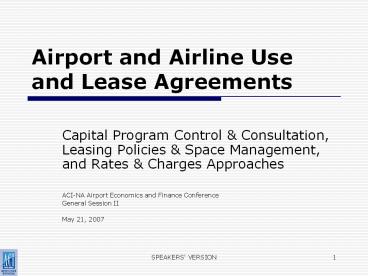Airport and Airline Use and Lease Agreements - PowerPoint PPT Presentation
1 / 24
Title:
Airport and Airline Use and Lease Agreements
Description:
Steve Sisneros, Regional Director, Southwest Airlines ... Shorter term airline agreements allow airlines to 'resize' more frequently and ... – PowerPoint PPT presentation
Number of Views:119
Avg rating:3.0/5.0
Title: Airport and Airline Use and Lease Agreements
1
Airport and Airline Use and Lease Agreements
- Capital Program Control Consultation, Leasing
Policies Space Management, and Rates Charges
Approaches - ACI-NA Airport Economics and Finance Conference
- General Session II
- May 21, 2007
2
Introduction
- At a majority of US airports Airport-Airline Use
Agreements form the basis for the business model
for the financial operations and space management
at US Airports. - A wide range of approaches used at various
airports what is right for your airport will
depend on the objectives of and circumstance at
your airport - Airport and airlines may occasionally have
differing perspectives on what is the optimal
approach as well - During this panel we are going to explore some of
pros and cons the different approaches taken by
airports in three focal areas, as viewed by some
airports that have recently negotiated new
agreements, airline representatives, an airport
consultant who has negotiated a number of airline
agreements.
3
Panel
- Susan Warner-Dooley, Deputy Executive Director,
Finance Administration, Minneapolis-St. Paul
Metropolitan Airports Commission - Vince Granato, General Manager, Financial
Services, Portland International Airport - Luis Navarro, Manager-Aviation Properties,
Seattle-Tacoma International Airport - R. Borgan Anderson, Manager, Aviation Finance and
Budget, Seattle-Tacoma International Airport - Trey Hettinger, Airport Properties
Representative, United Parcel Service - Steve Sisneros, Regional Director, Southwest
Airlines - Warren Adams, Director, Jacobs Consultancy
4
Format for the Session
- Three Areas of Focus
- Capital program control and consultation
processes - Leasing policy/space management
- Rates charges methodologies
- Process For Each Topic
- Overview
- Airport Approach
- Airline Perspective
- QA
5
Construction Control Consultation
6
Airline Involvement in Capital Project Decision
Making
- Degree of Airline Involvement
- Approve
- Disapprove (deemed approved unless airline
expressly disapproves) - Deferral
- Consult Only
- Areas Of The Airport That Are Covered
- Airfield
- Terminal
- Landside Other
7
Trends Capital Project Pre-Approval and
Exemptions
- Approved Programs and Thresholds
- Total Budget vs Approved List of Projects
- Discretionary Projects
- Typical Exclusions
- Safety, security, judgments, replacement
- Emerging Trends/Concepts in Exclusions
- Capacity-Enhancing Additional Passenger Terminal
Improvement Project / space for new or expanding
carrier - Expenditures for Planning Preliminary Design
- Potential New Exclusion
- AIP or PFC funded projects at certain funding
levels
8
Additional Notes
9
Capital Consultation QA
10
Leasing Policies and Space Management
11
Leasing Approach
- Trends
- Trend away from historical standard of exclusive
gates to preferential, common use, or combination
- Shorter term airline agreements allow airlines to
resize more frequently and to allow airport to
reevaluate the use of their space - Issues
- Common Use Terminal Equipment (CUTE)
- Vacancy risk for airport operators may be
increasing - New Approaches
- Formulas or changing ratio of preferential
common gates - Different gate use ratios based on number of
gates leased - Link gate use to airline approval of new gates
- Shift of financial risks of vacancies to airlines
12
Terminal BuildingsThe Next Big Investment
- About 40 of future capital needs focused on
terminal facilities
- Challenges with terminal projects
- Lack of institutional criteria for proceeding
- Limited sources of non-rate based capital
- Vacancy risk
- Changing mix of airline usage
13
Leased Space No Airport Control
- Low cost carriers are twice as efficient as
legacy carriers in use of terminal space - Near-term issue More vacancy risk in terminal
- Ongoing risk Constant airline restructuring
Note A higher bar means more passengers per
leased square foot of space.
14
NOTES CONTINUED
15
Space Management QA
16
Rates Charges
17
Industry Snapshot Rate Making Methodologies
- Broad Categories of Residual, Compensatory
Hybrid - There is no defined or standard approach
structure within the categories - The use of a particular rate-making approach is
typically integrally linked to other negotiated
factors, such as - Facility use
- Airline consultation or MII
18
Rate Making Methodology and Level of Cost Per
Enplaned PassengerNo Clear Link
19
Rate Charges Components
- Getting to the Bottom Line
- Airport Discretionary Funds or
Accumulated Surpluses
- Allocation of Risks/ Sharing of Revenues
- Cost Allocations and Recoveries
- Revenue Sharing
- Bottom Line Protections
20
Discretionary Funds and Accumulation of
Surpluses Taking Rating Agency Metrics into
Account
- Best Practices
- Link airline deal with key rating agency metrics
- Establish airport goals regarding RA metrics to
frame business deal
2005 comparisons
21
Interdependence Allocation of Revenues and
Costs, and Business Deal
- Allocation of revenues and costs has implications
for - Rates
- Risks
- Management
- Key issue--What portions get allocated to airline
cost centers and how are they distributed to the
airline rate-bases
22
Portland Cost Center and Rates and Charges
Methodologies
Residual Cost Centers
23
Seattle-Tacoma Rates and Charges Fundamentals
- Business Deal
- Airfield is a cost center residual
- Terminal is commercial compensatory residual (no
vacancy risk) - Allocations
- Roadway cost allocation 25 terminal, 25
Airfield and 50 Port - Debt service coverage rate base coverage zero
unless needed to achieve 1.25x overall coverage
24
Revenue SharingIndustry Trends
- About 77 of large hub airports have revenue
sharing - Cost center specific or
- Airport-wide
- Why?
- Emerging Trends/Concepts
- Extraordinary coverage protection
- Share revenues after all costs are reimbursed
(including Airport equity)
25
Bottom-Line Protections Incentives Any
Difference between Compensatory and Residual?
- Residual Deals
- Guaranteed payment of operating expenses and debt
service - Increased discretionary funds through expense
savings - Hybrid with/without Revenue Sharing
- Rate covenant protections
- Minimum coverage levels
- Extraordinary coverage protection
26
Rates Charges QA































